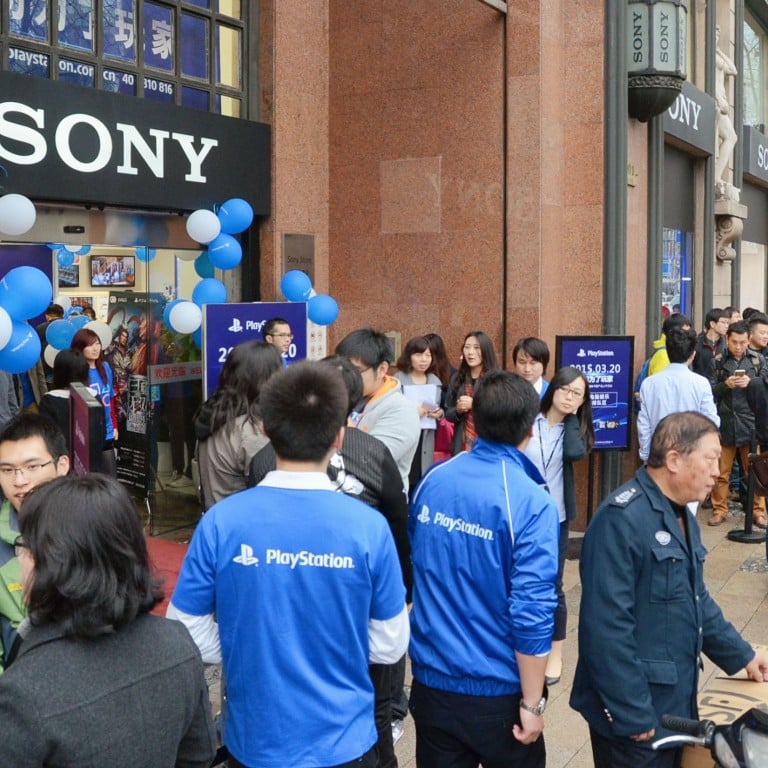
Long queues as Sony's Playstation 4 finally released in China... 16 months after the US
Japan’s Sony Corp is set to heat up a belated “console war” in China, the world’s second-biggest games market by revenue, as its PlayStation 4 and PlayStation Vita officially go on sale today on the mainland.
The PS4, which made its global debut in November 2013, has been priced at 2,899 yuan and the handheld PS Vita at 1,299 yuan.
Microsoft’s Xbox One, the software giant's all-in-one games and entertainment system, was the first major console of its kind to be introduced on the mainland last year, after the central government lifted a 14-year ban on foreign video game console sales with the opening of the Shanghai Free Trade Zone (FTZ) in September 2013.
"This is a remarkable day in the gaming history of the country. After such a long time, we can finally get our hands on the products through legitimate channels," wrote one enthusiastic Weibo commenter.
Sony initially slated the domestic release of its popular game consoles for January 11, but it was postponed at the request of mainland authorities. The company did not elaborate on reasons why.
Today’s mainland launch has Sony offering six government-approved game titles for the PS4, including Dynasty Warriors 8: Xtreme Legends from Japanese developer Omega Force and King of Wushu by local developer Suzhou Snail Digital Technology.
The PS Vita is being offered with seven game titles, including One Tap Hero by Shanghai Kena Information Technology and Final Fantasy X, co-developed by Japanese firm Square Enix and Shanghai-based Virtuos.
Online, there was some disappointment that the Chinese Playstation 4 would not offer access to streaming film, TV and music services as in the West, and that international multiplayer services would be limited. However, many commenters posted tips on how to circumvent restrictions on the consoles.
The two PS consoles and game software are being produced on the mainland under two separate joint ventures formed in May last year between Sony’s China arm, Sony Computer Entertainment Shanghai, and the state-owned Shanghai Oriental Pearl.
Despite this headway on the mainland, Sony still faces the stiff challenge of providing more game titles and meeting Chinese censorship rules.
“Just having the console is only the first step, access to high-quality games remains the biggest driver for console sales,” Jack Chuang, an associate partner at OC&C Strategy Consultants Greater China, told the Post.
“For the average gamer, access to major titles with Chinese subtitles or dubbed in Mandarin will be vital. Crucially, Sony has already committed to offering Chinese versions of some of their high-profile games, as well as titles from domestic developers.”
In December, Sony said its SCE Worldwide Studios and 70 third-party software developers and publishers will deliver a steady stream of software titles to gamers on the mainland.
Chuang said that the PS4 and PS Vita’s prospects on the mainland look good, despite the head-start of the Xbox One and Microsoft’s strategic move to reduce the price of its console.
“Despite the PS4 not being officially available in China since it was first released worldwide, underground sales have been strong as hardcore fans have purchased the console and games through other channels such as Taobao,” Chuang said.
Since 2000, mainland consumers managed to buy the three popular game platforms — the Xbox, Sony's PlayStation and Nintendo's Wii — through the grey market.
Research firm Niko Partners estimated that there are about one million game consoles sold through the mainland's grey market each year.
Data from research company Newzoo showed that mainland China’s total games market was estimated to be worth US$17.9 billion last year. The United States is the biggest market worldwide with US$20.5 billion in the same period.
Additional reporting by Adrian Wan

